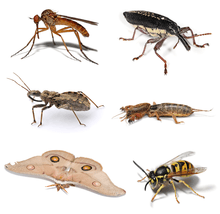Thysanura
| Thysanura | |
|---|---|
| Scientific classification | |
| Kingdom: | Animalia |
| Phylum: | Arthropoda |
| Class: | Insecta |
Thysanura is the now deprecated name of what was, for over a century, recognised as an order in the class Insecta. The two constituent groups within the former order, the Archaeognatha and the Zygentoma, share several characteristics, such as of having three long caudal filaments, the lateral ones being the cerci, while the one between is a medial cerciform appendage, specifically an epiproct. They are also both wingless, and have bodies covered with fine scales, rather like the scales of the practically unrelated Lepidoptera. In the late 20th century, it was recognized that the two suborders were not sister taxa, therefore Thysanura was paraphyletic, and the two suborders were each raised to the status of an independent monophyletic order, with Archaeognatha sister taxon to the Dicondylia, including the Zygentoma.[1][2]
.jpg)
Although the group Thysanura is no longer recognized, the name still appears in some published material.[3]
Etymology
The name Thysanura was derived from the Greek θυσάνος, thysanos for fringe, tassel, bristle and οὐρά, oura for tail, a reference to the three fanned out caudal filaments. This etymology is consistent with the English word "bristletail," which is the common name for several hexapod species, not all of which fell within Thysanura.[4]
References
- ↑ A. Blanke, M. Koch, B. Wipfler, F. Wilde, B. Misof (2014) Head morphology of Tricholepidion gertschi indicates monophyletic Zygentoma. Frontiers in Zoology 11:16 doi:10.1186/1742-9994-11-16
- ↑ P. J. Gullan; P. S. Cranston (13 July 2010). The Insects: An Outline of Entomology. John Wiley & Sons. pp. 202–. ISBN 978-1-4443-1767-1.
- ↑ Richards, O.W.; Davies, R.G. (1977). Imms' General Textbook of Entomology: Volume 1: Structure, Physiology and Development Volume 2: Classification and Biology. Berlin: Springer. ISBN 0-412-61390-5.
- ↑ Eric Tentarelli (2012). A Guide to Insects. Blackwell. p. 220.
- Grimaldi, D. and Engel, M.S. (2005). Evolution of the Insects. Cambridge University Press. ISBN 0-521-82149-5.
- Charles A. Triplehorn and Norman F. Johnson, Borror and DeLong's Introduction to the Study of Insects, 7th edition (Thomas Brooks/Cole, 2005), pp. 177–180
- Firefly Encyclopedia of Insects and Spiders, edited by Christopher O'Toole, ISBN 1-55297-612-2, 2002
External links
| Wikimedia Commons has media related to Thysanura. |
| Wikispecies has information related to Zygentoma |
- Thysanura – Tree of Life Web Project
- Virginia Extension Service Article
